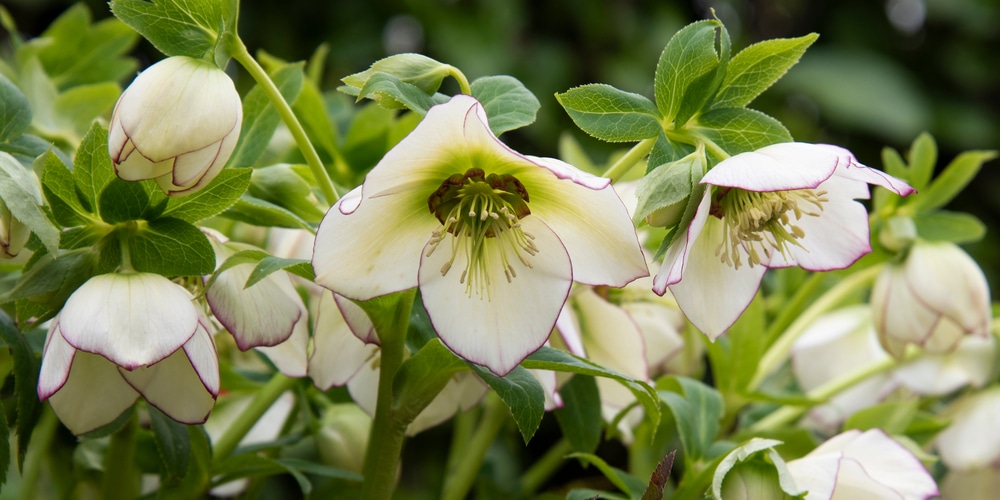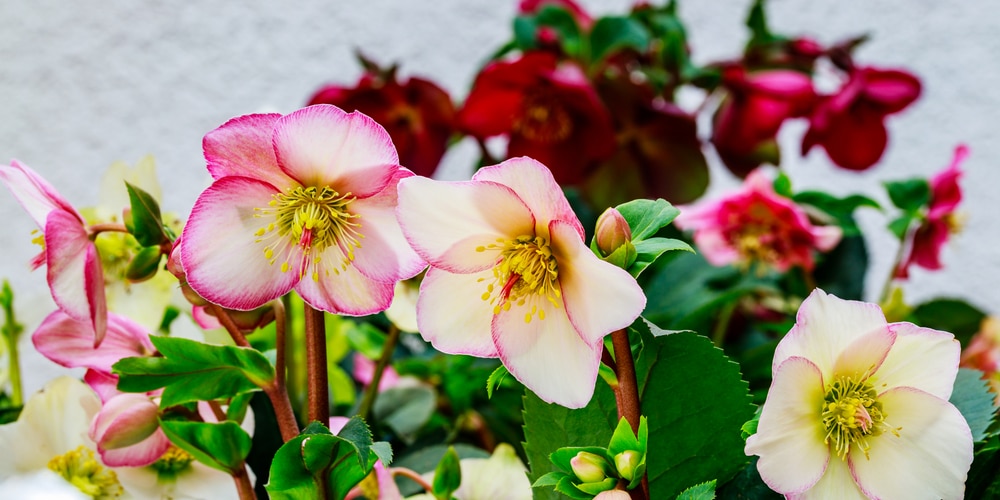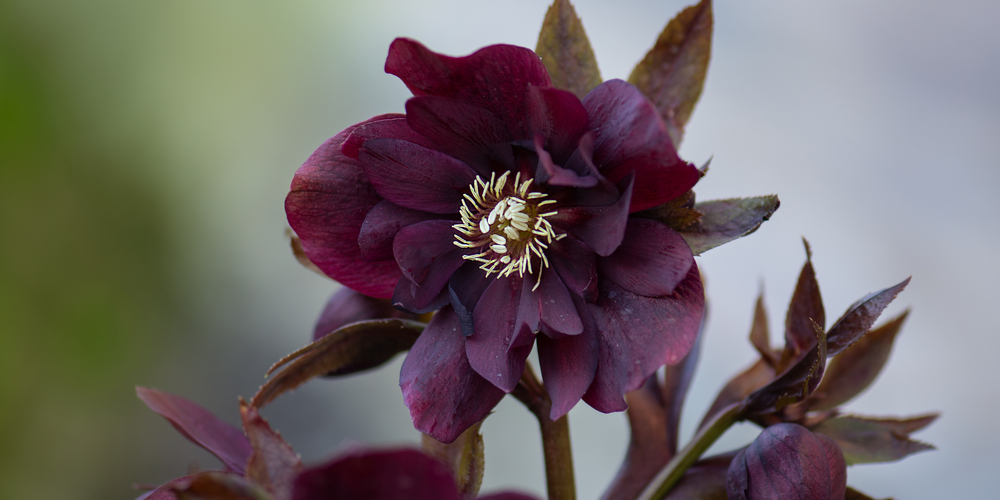Few plants can rival the elegance of Helleborus Orientalis in the flower garden. These graceful flowers are a sight to behold, with their nodding blooms and distinctive veining.
Prized for their winter bloom period, these shade-loving plants are perfect for adding some color to the garden when other flowers have faded. Helleborus Orientalis is easy to care for and make wonderful cut flowers, and they are most popular during the Christmas season.
| Botanical Name | Helleborus Orientalis |
| Common Name | Lenten Rose, Christmas Rose |
| Plant Type | Perennial |
| Flower Color | Pink flowers, with a cup-shaped appearance |
| Size When Mature | 18 inches |
| Bloom Time | Mid to Late Winter |
| Sun Requirements | Partial Sun to Shade |
| USDA Hardiness Zones | 4a – 9b |
| Soil PH Range | 7.0 – 8.0 |
| Soil Type | Neutral to alkaline, well-draining, loam |
| Water Needs | Low |
| Native Area | Greece and Turkey |
What You Need to Know About Helleborus Orientalis
More commonly known as the Lenten Rose or the Christmas Rose, it is a perennial flowering plant found throughout Asia, Europe, and other parts of North America.
These plants blossom during late winter and early spring, providing a much-needed splash of color in the often bleak landscape.
The flowers themselves are bowl-shaped and range in color from white to pink to deep purple, although they’re more often seen on the lighter end of the spectrum.
They are particularly prized for their long-lasting blooms, lasting up to two weeks. Brimming with nectar, the flowers are also a favorite of bees and other pollinators. The foliage of this plant is unique in that it features a dark green color with white veins running through it. This makes for a beautiful contrast against the flowers.
It features a glossy dark green texture with wrinkled and toothed edges. The veins on the leaves are a white or silver color, which also helps to set it apart from other plants. The overall size of the leaves can vary depending on the variety, but some may reach up to 16 inches wide.
This low-maintenance plant is perfect for gardens of all sizes. It can tolerate a wide range of growing conditions, making it a versatile choice for gardeners. Helleborus Orientalis is deer resistant and can even thrive in shady areas.
How to Care for Helleborus Orientalis
Here’s everything you need to know about growing and caring for a thriving Helleborus Orientalis.
Light
A shade-loving plant, Helleborus Orientalis does best in areas that receive dappled sunlight or full shade. While it’s not picky, this plant will produce flowers when in the sun or shade.
These plants will tolerate some sun, but too much direct sunlight can cause the leaves to scorch. Providing this sun with some filtered sun or shade will help to prevent this.
Little to no sun may cause the plant to produce fewer and less vibrant flowers. Striking a balance between sun and shade is key to keeping this plant happy. It’s best to provide at least 6 hours of filtered sunlight or dappled shade during the blooming period to encourage flowers.
When planting indoors in a pot, place the pot in an area that receives indirect sunlight. A north-facing window is a good option.
Water and Soil Needs
Treasured for centuries, this winter bloomer is quite adaptable when it comes to soil types. It will happily grow in just about any type of garden soil, as long as it is well-drained.
This plant will provide color and life to the dreary season no matter which soil it was planted to. If you’re not sure about your soil’s drainage, simply dig a hole and fill it with water. If the water drains away within an hour or two, your soil is well-suited for the Lenten Rose.
If you have heavy clay soil, consider amending it with some organic matter to improve drainage.
When watering your Christmas rose, remember that it does not like to sit in wet soil, and water this plant only when the top inch of soil is dry. It is best to let the soil dry out completely between watering.
During the blooming period, however, you may need to slightly increase watering to prevent the flowers from wilting. You’ll know that your plant needs more water when you notice that the leaves start to droop.
As far as pH goes, the Helleborus Orientalis prefers neutral to alkaline, loamy soil, with a pH of 7.0 – 8.0. This plant needs a lot of water during its growing season to help establish its roots. Watering every week or two should suffice. Once it’s established, however, it becomes pretty drought-tolerant.
Temperature Requirements
The Helleborus Orientalis can survive in USDA climate zones 4a-9b. These regions experience minimum temperatures of -30 to 20 degrees Fahrenheit. When planting outdoors, make sure to choose a spot that is protected from harsh winds.
If you live in an area with hot summers, some afternoon shade will help to protect the plant from wilting in the heat. Otherwise, these stunning flowers will become heat-stressed and may not bloom as profusely.
The Christmas rose does best in temperatures between 60 and 70 degrees Fahrenheit when growing indoors. If you need to move your pot outdoors during the warmer months, do so gradually to avoid shocking the plant.
Fertilizer
The best fertilizer to use on a Helleborus Orientalis is a slow-release fertilizer high in phosphorous to encourage blooming.
Additionally, because this plant prefers neutral to alkaline soil, using a fertilizer with a higher pH level will also be beneficial. The best season to fertilize your Lenten rose is in the spring, just as the plant is coming out of dormancy.
Common Diseases
Although it is hardy and easy to care for, there are a few common diseases that can affect this plant. Powdery mildew is one of the most common problems, causing a white or gray powder to form on the leaves and stems. Left unchecked, this fungus can cause the plant to become stunted and may even kill it.
To prevent powdery mildew, water the plant at the base rather than from above, and make sure the leaves are dry before nightfall. If powdery mildew does appear, treat with a fungicide designed for powdery mildew.
Another common problem is botrytis blight, which can cause the leaves and flowers to turn brown and wilt. This disease is often caused by too much moisture, so be sure to plant hellebores in well-drained soil and water them only when the soil is dry.
If botrytis blight does occur, remove affected leaves and flowers and get rid of them. You may also need to treat the plant with a fungicide labeled for botrytis blight.
Helleborus Orientalis Propagation
One of the best ways to propagate Helleborus Orientalis, also known as Lenten Rose, is by division. This can be done in late summer or early fall when the plant is not actively blooming.
First, dig up the plant and carefully divide it into sections, ensuring each section has a good amount of roots. Next, replant the sections in well-drained soil and water thoroughly.
When dividing Lenten Rose, it’s essential to take care not to damage the roots, as this can lead to poor growth. Do this by gently loosening the roots before division. Once the plant is divided, water it well and give it a little time to adjust to its new location.
You can also propagate hellebores from seed, although this is a slower process. The best time to sow seeds is in late summer or early fall. To do this, simply scatter the seeds on the surface of well-drained soil and lightly press them in.
Water the seeds well and keep the soil moist until they germinate, which can take several weeks. Once the seedlings appear, thin them out so that each one has enough room to grow.
Final Thoughts
The Helleborus Orientalis, more commonly known as the Lenten Rose, is a beautiful and unique flower. It is one of the few blooming plants that can withstand cold temperatures and still look beautiful.
The petals are delicate and fragile, yet they are also strong and resilient. Each flower is unique, with its own pattern of markings. No two blooms are exactly alike.
The Lenten Rose is a symbol of hope and strength. It reminds us that there is always the possibility of new life and new beginnings even in the darkest of times.
Related Article: Roses for Zone 10


